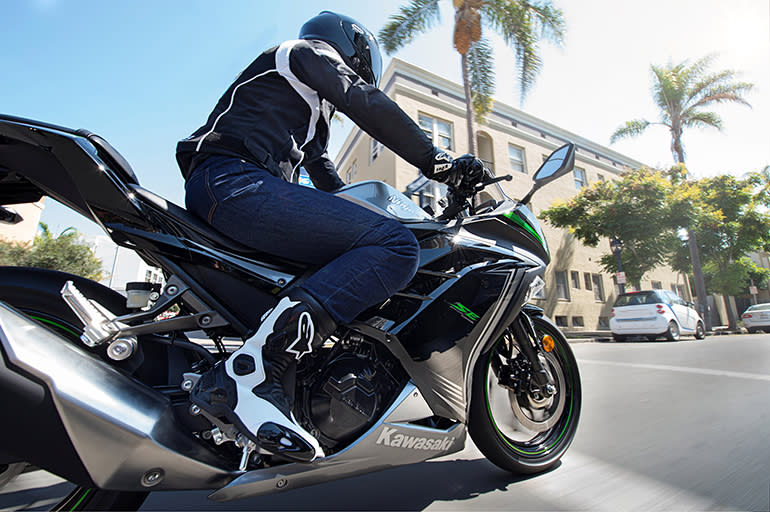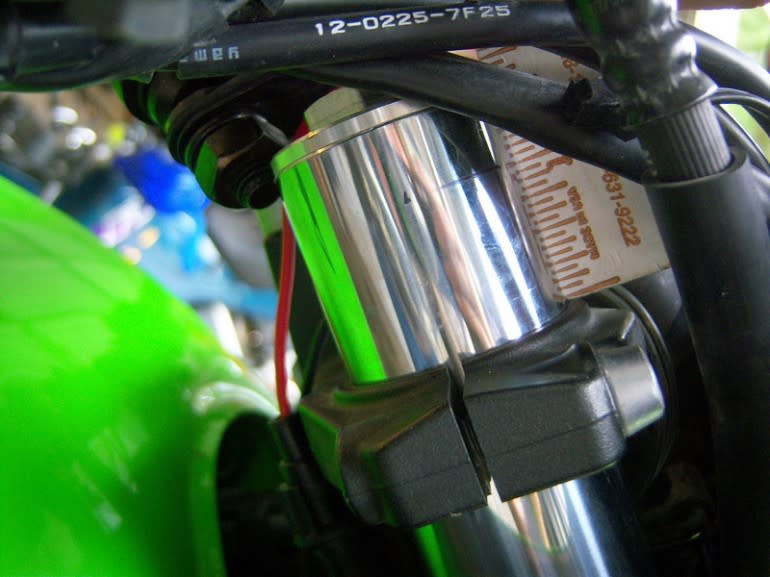Attention Short Riders: How to Lower Any Motorcycle
Face pressed against the window at the local dealership, fog covering the window from your breath. You close your eyes and dream of wind blowing past your helmet as you rocket down the highway, curvy roads for miles on your brand new motorcycle.
Then you open your eyes to realize you're very short, looking at a very tall motorcycle. You're 5' 5" and staring at a KTM Super Duke with a stock seat height of 32.9 inches, and you're cursed with a 28 inch inseam. Seems completely incompatible doesn't it? But all is not lost - there's still hope.
How to Lower Any Motorcycle
Ride Smarter, Not Taller
The first, easiest, and cheapest method involves you as the rider and your comfort level. Very short riders are sometimes forced to rest on one leg at a stop. It's a myth that you have to be flat-footed on both feet at every stop, in order to ride a motorcycle.
READ MORE: How To: Suspension Setup
Depending on the size of the bike you can also lean it over to the side and balance it. These are imperfect methods, but with confidence and practice they can become second nature. For some riders this is never comfortable so we move on to other options.
Check It Out
Most bikes suspensions come set up for a 180 pound rider. That's assuming they're even set up properly when shipped and delivered new. If the bike is set up for a rider that's heavier than you, it will ride taller and make it harder for a shorter rider to reach the ground. The springs don't sag to their proper height under load and hold the rider up in the air. Before you make any parts changes or other permanent adjustments, check your suspension sag. This will help riders who are close to touching both feet and will certainly improve the ride overall regardless of height changes. (For additional information, Touratech also did a great article on checking suspension sag.)
Lower Your Butt
One option that I personally love is lowering the seat. This gives riders a better reach to the ground, improves the comfort of the seat and riders can tailor it to fit their backsides. In many cases riders are going to replace the seat anyway for comfort, so this step makes even more sense.
READ MORE: Buyers Guide: Portable Solar Power
The great thing about this method is you can shave the front portion of the seat to make it thinner at the nose. This makes it easier to touch the ground because your legs don't have to be as spread apart to wrap around the bike. The seat can be wider where you sit leaving plenty of comfort. It's less intrusive than many of the other options.

Lower the Bike
If all of the above doesn't work, the last resort is to lower the suspension of the bike. It's a last resort for a reason. Changing the suspension of your motorcycle is not to be done lightly. Lowering a bike changes the amount of lean angle available, changes the handling and impacts ground clearance for obstacles like speed bumps. Hard parts hit sooner than they would otherwise, and if done improperly make the bikes handling erratic and dangerous. Dragging pegs may sound cool on paper, but it's not fun when those dragging pegs hit a pot hole or imperfection in the asphalt. I've known several riders who have gone down from dragging pegs.
READ MORE: How To: Easy Fork Seal Repair
How to lower it? Most bikes have a rising rate rear linkage that uses what many refer to (thanks to its appearance) as a dog bone. Each bike is different, but in many cases a longer dog bone will lower the bike. Be careful with this, because the linkage multiplies changes. It does not take a large change in length to radically alter the height. This also changes the spring rate. A change as little as 10mm can increase the compression rate of the spring by 20 percent. That can make the ride a lot harsher. The amount of change depends on the rate of rise in the linkage. Every bike and rider requires different amounts of change for different results. Remember that these are only tips; check with your local dealer or forums on how to do it yourself.
Another option is to shorten the rear shock. This is not a cheap option, but it does retain the factory spring rate and also your factory rate to the linkage. Averaging over $200 to have it done professionally, it can cost up to three times as much as it would to replace the dog bone. The benefit of shortening the rear shock: it does maintain the factory ride.

When you lower the rear of the motorcycle by replacing the dog bone you should lower the front end to match. This more than anything will dictate how much you can lower a motorcycle. If you do not lower the forks, you change the overall weight balance of the motorcycle, altering the front end geometry and slowing the steering.
This last part is the source of much controversy. Many people say to never lower the front, others swear by it; there are articles and schools of thought that defend and bash each aspect of it. The main issue is that there is a small area of adjustment with front forks before you start hitting the front fender into the triple trees. This can be very dangerous and easy to do, as many don't take into consideration about the suspension compression you experience under braking.
[EDIT NOTE: The above video may not be the best example of things dragging, but another thing to note is proper body position/riding. You should shift your body weight into a corner, standing the bike more upright, decreasing the chances of dragging on any bike. Also, to repeat the above, the front fenders dragging on the front wheel can be dangerous.]
Read up on your options and visit forums for your particular bike. Unless it's a full blown custom, chances are others have already tried to lower your bike.

Have you lowered your motorcycle? What method did you use? Comment Below.
Lead photo courtesy of Touratech.

Follow RideApart on Facebook and Twitter, along with @RideApart on Instagram.

 Yahoo Autos
Yahoo Autos 
